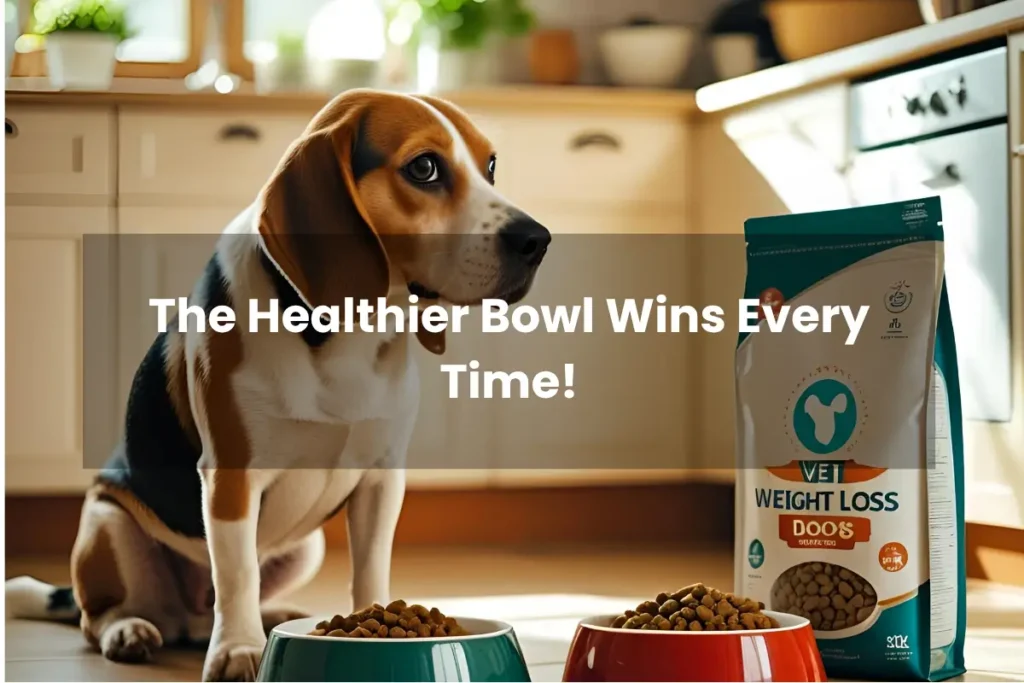“Discover the best weight loss dog food to help your pup shed pounds safely. Learn how to help your dog lose weight with vet recommended tips. Learn more now!”
I still remember the day I noticed my dog struggling to jump on the couch. That small moment led me to explore weight loss dog food, hoping to find a real solution—not just by feeding less, but by feeding smarter. After talking to my vet and trying a few trusted brands, I learned what actually works. The right food made a huge difference, and my dog is now more active and happy. In this article, I’ll share everything I’ve learned to help your dog lose weight the safe and healthy way.
1.Why a Special Weight‑Loss Dog Food?

Why a Special Weight‑Loss Dog Food?
Not all dog food is created equal, especially when it comes to helping your furry friend shed extra pounds. Regular dog food often contains more calories and fat than your dog actually needs, making weight loss a real challenge. That’s why choosing a special weight loss dog food matters so much. These foods are designed with fewer calories, higher fiber, and lean proteins to keep your dog feeling full and satisfied, while helping them lose weight safely and steadily. It’s not about feeding less—it’s about feeding smarter.
1.1 What Makes It Different from Regular Diets
I used to think that simply feeding my dog less would solve the problem. But cutting back on regular food left my dog hungry and low on energy. That’s when I learned about weight loss dog food, which is different because it has fewer calories and less fat, but more fiber to promote fullness. Many of these formulas include lean proteins and supplements like L-carnitine that support fat burning and muscle maintenance. This means your dog can enjoy meals that help them lose weight without feeling deprived or losing essential nutrients.
Weight loss dog food offers lower calories, more fiber, and added nutrients to support safe and effective weight loss.
1.2 Backed by Science & Veterinarians
When my vet recommended a vet recommended dog food for weight loss, I was curious if it really worked. These diets aren’t just popular—they’re backed by science and clinical studies. Vets often prescribe these therapeutic diets as part of a structured weight loss plan that combines proper nutrition, calorie control, and exercise. This approach helps dogs lose fat while keeping muscle and overall health intact.
Vet-approved weight loss dog foods are clinically tested and part of safe, effective weight management programs.
If you’re asking yourself, “What is the best dog food for weight loss?” the answer lies in foods specially formulated for weight control and endorsed by veterinarians. These diets give you a safe, proven way to help your dog reach a healthy weight.
2. Key Nutritional Features to Look For
When choosing the best weight loss dog food, understanding the key nutritional features can make all the difference. From my experience and vet advice, these are the main things to watch for.
2.1 High Fiber, Low Calorie
Fiber is like the unsung hero of weight loss diets. It helps your dog feel full longer without adding extra calories. A good weight loss dog food usually has about 300 calories per cup, though servings depend on your dog’s size. This low-calorie, high-fiber combo helps reduce hunger and makes sticking to the diet easier for both you and your pup.
High fiber and low calories keep your dog satisfied while promoting steady weight loss.
2.2 Quality Lean Protein & Added Benefits
Protein is essential to keep your dog’s muscles strong as they lose fat. Look for whole-food protein sources like chicken, turkey, or fish meal in the formula. Some weight loss foods also include helpful extras like L-carnitine, taurine, glucosamine, or chondroitin. These support fat metabolism, heart health, and joint care — especially important if your dog is older or less active.
Lean protein preserves muscle, while added supplements support overall health during weight loss.
2.3 AAFCO-Approved Complete & Balanced
Lastly, make sure the food is AAFCO-approved for your dog’s life stage. This means it meets all the nutritional standards to keep your dog healthy. Even when cutting calories, your dog still needs balanced nutrition to thrive.
Choose AAFCO-approved formulas to ensure complete and balanced nutrition during weight loss.
3. Vet-Recommended Brands & Formulas
Finding the best dog food for weight loss can feel overwhelming. When I started my dog’s weight loss journey, I looked for brands my vet trusted. That made me feel more confident about what I was feeding my furry friend.
Some top vet recommended dog food for weight loss options include Wellness Complete Health Healthy Weight (dry food) and Hill’s Science Diet Adult Perfect Weight, which comes in both canned and dry forms. These formulas are designed to support healthy weight loss with balanced nutrition.
Other great choices to consider are Blue Buffalo Healthy Weight, Royal Canin Weight Care, and Purina Pro Plan Weight Management. All of these are formulated to help dogs shed pounds safely without missing key nutrients.
Vet-recommended weight loss dog foods combine low calories with essential nutrients to support your dog’s health during weight loss.
Remember, food choice alone isn’t enough. Pairing the right diet with vet advice, portion control, and regular exercise is key. This combo helped me help my dog lose weight and feel better every day.
4.Step‑by‑Step: How I Helped My Dog Lose Weight

Step‑by‑Step: How I Helped My Dog Lose Weight
When I started noticing my dog slowing down, gaining weight, and skipping playtime, I knew something had to change. I didn’t want to take chances with just feeding less or guessing what might work. Instead, I followed a simple, step-by-step approach—and it made all the difference. Here’s exactly what worked for me and how you can help your dog lose weight safely too.
4.1 Veterinary Check & Body Condition Assessment
The first step I took was booking a vet visit. I needed real answers—not guesses. My vet used a Body Condition Score (BCS) chart to show me where my dog stood and what our healthy target weight should be. This chart helped me understand if my dog was slightly overweight or truly obese.
Always start with a vet check. Use a BCS chart to find your dog’s ideal weight and calculate daily calories.
We also talked about calorie needs. My vet used my dog’s weight and activity level to create a custom calorie goal. That gave me a solid foundation for choosing the right weight loss dog food and setting up a meal plan.
4.2 Gradual Transition to New Food
Switching to a weight loss food for dogs isn’t something you want to rush. I made the mistake of changing food too quickly once, and my dog ended up with an upset stomach. So this time, I did it right—slow and steady.
Transition gradually over 7 days—start with 25% new food, increase slowly to 100%.
Here’s what worked:
- Days 1–2: 25% new / 75% old food
- Days 3–4: 50% new / 50% old
- Days 5–6: 75% new / 25% old
- Day 7: 100% new food
This gentle switch helped avoid stomach issues and let my dog get used to the new taste and texture of the best dog food for weight loss I had picked based on my vet’s advice.
4.3 Precise Portion Control & Treat Management
This part was eye-opening. I used to “eyeball” portions, and it turns out I was feeding too much. Now I use a digital food scale and measure every single meal. Precision matters when you want to help your dog lose weight.
Use a food scale or exact measuring cup to avoid overfeeding—even a few extra bites can stall progress.
Also, treats can sneak in a lot of extra calories. I kept all treats under 10% of daily intake and swapped high-calorie snacks for green beans or apple slices (no seeds!). These small changes added up fast and kept my dog satisfied between meals.
4.4 Exercise & Enrichment
Feeding right is only half the puzzle. My dog also needed to move more—but in ways that felt fun and not forced. We started with short walks, just 10–15 minutes twice a day. Over time, we added games like fetch, gentle hikes, and even puzzle feeders for mental stimulation.
Combine walks, playtime, and fun activities to burn calories and boost your dog’s mood.
It wasn’t just about exercise—it was about connection. My dog looked forward to these moments, and so did I. The extra movement helped burn off calories from food while building muscle and boosting energy levels.
4.5 Monitoring & Adjusting
One thing I learned is that weight loss isn’t always a straight path. Every 4–6 weeks, I weighed my dog and tracked progress. Sometimes we made great progress. Other times the weight plateaued—and that’s okay.
Weigh your dog every 4–6 weeks and adjust calories or exercise if weight loss slows.
If the weight didn’t drop as expected, I recalculated calorie needs with my vet’s help and slightly reduced food or increased playtime. This helped keep things on track without starving or overworking my dog. Every adjustment was small, but it helped us reach the next milestone.
Conclusion
Helping my dog lose weight was not easy at first. But choosing the right food made a big difference. I learned that not all dog foods are the same. Special weight-loss dog food gave my pet the nutrition he needed—without the extra fat or calories.
Today, he is more active, happy, and full of life. Watching him run and play again made it all worth it.
If your dog is struggling with weight, don’t wait. Talk to your vet. Try a trusted weight-loss dog food. A small change can lead to a big difference in your dog’s life.
FAQs About Weight Loss Dog Food
Q1. What is the best dog food for weight loss?
A: The best dog food for weight loss is low in calories, high in fiber, and vet recommended. Look for trusted brands like Hill’s, Royal Canin, or Wellness.
Q2. Can I feed less of my dog’s regular food to help them lose weight?
A: No. Regular food may lack key nutrients when cut. Use weight loss dog food made to support safe weight control with balanced nutrition.
Q3. How fast can my dog lose weight with weight loss food for dogs?
A: Dogs may lose 3–5% of their body weight each month. Full results may take 6–8 months with proper food, exercise, and vet guidance.
Q4. What makes vet recommended dog food for weight loss different?
A: Vet recommended dog food for weight loss is tested for results. It’s made to reduce fat while keeping muscle and meeting nutrient needs.
Q5. Is dry or canned weight loss food better for dogs?
A: Both dry and canned food work. Canned may help dogs feel fuller. Track calories if you mix both types to stay within their daily limit.
Q6. Can older dogs eat weight loss dog food safely?
A: Yes. Many weight loss foods for dogs include joint support and higher protein, which help older dogs stay strong while losing weight.
Q7. How do I help my dog lose weight safely at home?
A: Use a vet-approved weight loss dog food, control portions, limit treats, and add daily walks or play to boost weight loss progress.
Q8. Are all weight loss foods complete and balanced for dogs?
A: Not always. Pick AAFCO-approved foods to make sure your dog gets all needed nutrients, even when on fewer calories.
Q9. What treats can I give my dog on a diet?
A: Offer low-calorie treats like carrots or green beans. Keep treats under 10% of their daily calories to stay on track with weight loss.
Q10. Can weight loss dog food help dogs with joint issues?
A: Yes. Many formulas include glucosamine or chondroitin, which support joints and ease strain as your dog sheds extra weight.

